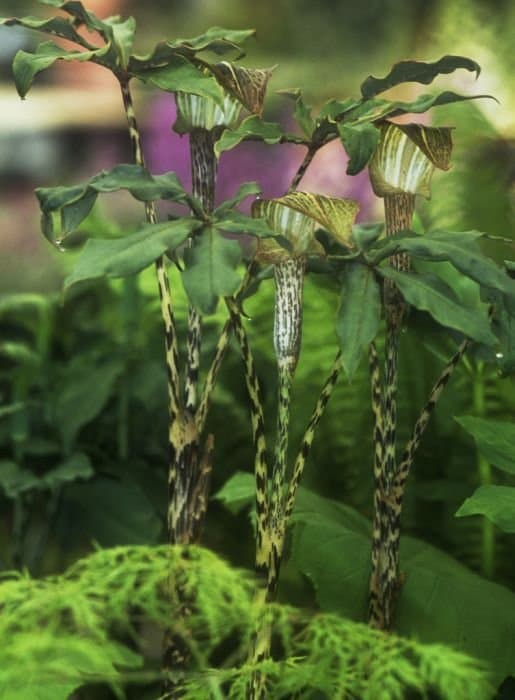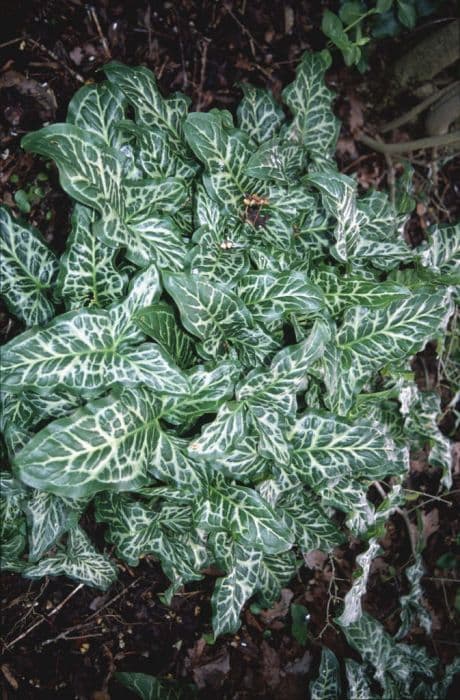Calla Lily 'Royal Snowland' Zantedeschia 'Royal Snowland'

ABOUT
The Zantedeschia 'Royal Snowland', commonly known as calla lily, is a striking plant that features elegant, trumpet-shaped flowers. These blooms exhibit a pristine white color that can indeed remind one of a snowy landscape. The flowers gracefully curve into a funnel shape, encasing a central, finger-like spadix that often has a contrasting yellow hue, adding an extra layer of visual interest. Surrounding the spadix is a modified leaf called a spathe, which is what most people think of as the petal, although it's not technically correct. The leaves of 'Royal Snowland' calla lily are glossy and arrow-shaped, showcasing a deep green with distinctive white or lighter green spots scattered across their surface. These speckles give the foliage an almost ornamental quality even when the plant is not in bloom. The leaves grow directly from the soil, and each individual leaf emerges on its own long stalk. Overall, the appearance of 'Royal Snowland' calla lily resonates with elegance and simplicity, with the contrasting colors of the blooms and the spotted foliage heightening its decorative appeal. This plant’s refined beauty has made it a popular choice both in gardens and as a cultivated flower for special occasions and floral arrangements.
About this plant
 Names
NamesFamily
Araceae
Synonyms
Calla Lily, Arum Lily
Common names
Zantedeschia 'Royal Snowland'
 Toxicity
ToxicityTo humans
The plant known as calla lily is poisonous to humans when ingested. It contains calcium oxalate crystals, which can cause injury to the mouth and gastrointestinal tract. Symptoms of poisoning may include a burning sensation in the mouth and throat, nausea, vomiting, diarrhea, swelling of the lips, tongue, and throat, which can lead to difficulty swallowing and even breathing difficulties in severe cases. It's important to handle these plants with care and to keep them away from children who might accidentally ingest them.
To pets
The calla lily is also toxic to pets, such as dogs and cats. Much like in humans, the ingestion of calla lilies can cause severe irritation in the mouth, tongue, and throat due to the presence of calcium oxalate crystals. This can lead to symptoms like drooling, difficulty swallowing, vomiting, and a decrease in appetite. In severe cases, it can cause respiratory problems if swelling obstructs the airway. It is advisable to keep calla lilies out of reach of pets to prevent accidental poisoning.
 Characteristics
CharacteristicsLife cycle
Perennials
Foliage type
Deciduous
Color of leaves
Green
Flower color
White
Height
1-2 feet (30-60 cm)
Spread
1-2 feet (30-60 cm)
Plant type
Herb
Native area
South Africa
Benefits
 General Benefits
General Benefits- Ornamental Value: Zantedeschia 'Royal Snowland', commonly known as Calla Lily, is appreciated for its striking white spathe flowers and lush green foliage, which add elegance and beauty to gardens and floral arrangements.
- Long Blooming Season: The Calla Lily has a lengthy blooming period that can last from late spring into summer, offering extended visual enjoyment.
- Low Maintenance: Calla Lilies are known for being relatively low maintenance, requiring minimal care aside from regular watering and occasional fertilization.
- Versatility in Landscaping: With their sleek and sculptural look, Calla Lilies can be used in a range of garden designs, from borders and flower beds to container gardening.
- Attracts Pollinators: Calla Lilies can attract butterflies and other pollinators, which is beneficial for the health of the garden and local ecosystems.
- Drought Tolerance: Once established, Calla Lilies have some drought tolerance, making them suitable for gardens in drier climates with careful water management.
- Perennial Growth: As a perennial plant, the Calla Lily will typically come back year after year, providing long-term value to the garden.
- Suitable for Cut Flowers: The blooms of the Calla Lily are popular in cut flower arrangements due to their long vase life and elegant appearance.
 Medical Properties
Medical PropertiesThis plant is not used for medical purposes.
 Air-purifying Qualities
Air-purifying QualitiesThis plant is not specifically known for air purifying qualities.
 Other Uses
Other Uses- Biodegradable Plant Pots: The sturdy stems and leaves can sometimes be used to create small, biodegradable plant pots or containers for seedlings.
- Floral Jewelry: Small blooms of the calla lily can be fashioned into delicate pieces of jewelry such as earrings or pendants.
- Artistic Inspiration: The elegant form of calla lilies serves as an artistic muse for painters and photographers capturing their unique shape and vibrant colors.
- Education: The plant can be used to teach botany and horticulture lessons due to its distinct flower structure and growth patterns.
- Decorative Pressing: The flowers and leaves can be pressed and used in decorative crafts, such as creating bookmarks or artwork.
- Eco-friendly Confetti: Dried flower petals can be used as a biodegradable alternative to traditional paper confetti at celebrations.
- Natural Dyes: The pigments in the petals of some calla lily varieties can be used to create natural dyes for fabrics or artwork.
- Theme Gardens: Calla lilies can be used as a thematic element in gardens designed around a specific color scheme or aesthetic, like a white garden.
- Photography Props: The calla lily's flowers make for elegant props in portrait and still life photography.
- Culinary Garnish: Although not edible, the flowers can be used as a temporary, decorative garnish for elegant plating in high-end culinary presentations.
Interesting Facts
 Feng Shui
Feng ShuiThe Calla Lily is not used in Feng Shui practice.
 Zodiac Sign Compitability
Zodiac Sign CompitabilityThe Calla Lily is not used in astrology practice.
 Plant Symbolism
Plant Symbolism- Beauty: The Zantedeschia 'Royal Snowland', commonly known as the Calla Lily, often symbolizes beauty due to its elegant and smooth contours.
- Purity: Its pristine white blooms can represent innocence and purity, making it a popular choice for weddings and religious ceremonies.
- Resurrection and rebirth: The Calla Lily is also associated with rebirth and resurrection, particularly around Easter due to its flower form that resembles a trumpet and its seasonal blooming time.
- Overcoming challenges: As a plant that can grow in marshy conditions, the Calla Lily sometimes symbolizes triumph over trials and the ability to flourish despite hardships.
- Transcendence: Its sophisticated and otherworldly shape can signify transcendence and an overcoming of the material world.
- Devotion and faithfulness: Given as a gift, the Calla Lily may represent the sender's devotion or recognize faithfulness and loyalty in the recipient.
 Water
WaterCalla lilies, including the Zantedeschia 'Royal Snowland', prefer evenly moist soil and should be watered when the top inch of soil feels dry to the touch. Water them deeply with about 1 gallon of water per plant, ensuring that the water penetrates the soil well without causing standing water, which can lead to root rot. During the growing season, this could mean watering as often as once a week, but always adjust frequency based on temperature, humidity, and rainfall. In the winter, reduce watering to keep the soil slightly drier as the plant enters dormancy
 Light
LightCalla lilies thrive in bright, indirect light. The ideal spot for Zantedeschia 'Royal Snowland' is where it can receive filtered sunlight for most of the day, such as a northern or eastern-facing window. Direct afternoon sun can scorch the leaves, so avoid placing your calla lily in direct, harsh light, particularly during the hot summer months
 Temperature
TemperatureCalla lilies prefer temperatures between 60 and 75 degrees Fahrenheit for optimal growth. The Zantedeschia 'Royal Snowland' can tolerate a range between 50 and 80 degrees but will not survive temperatures below 50 degrees Fahrenheit or above 80 degrees for extended periods. They perform best when night temperatures are slightly cooler than daytime temperatures, which helps to replicate their native environment
 Pruning
PruningPruning calla lilies like Zantedeschia 'Royal Snowland' involves removing spent flowers and yellowing leaves to encourage further blooming and maintain the plant's appearance. This should be done as needed throughout the growing season. After flowering has finished and the foliage has yellowed, cut back the leaves to ground level to prepare the plant for dormancy. The best time for major pruning is late fall or early winter after the plant has died back
 Cleaning
CleaningAs needed
 Soil
SoilCalla Lily 'Royal Snowland' prefers well-draining soil rich in organic matter with a pH of 6.0–6.5. A mix of two parts peat moss, one part perlite, and one part garden soil would be ideal to ensure adequate drainage and fertility.
 Repotting
RepottingCalla Lilies, including 'Royal Snowland', should be repotted every 2 to 3 years to refresh the soil and allow room for growth. Overcrowded bulbs can lead to smaller blooms and should be divided during repotting.
 Humidity & Misting
Humidity & MistingCalla Lily 'Royal Snowland' thrives best at a moderate humidity level of about 40-60%. Avoiding excessively dry air is key to maintaining healthy foliage and vibrant blooms.
 Suitable locations
Suitable locationsIndoor
Provide bright, indirect light and keep soil moist for Calla Lily 'Royal Snowland'.
Outdoor
Plant in partial shade, keep soil moist, and protect from harsh sun for Calla 'Royal Snowland'.
Hardiness zone
8-10 USDA
 Life cycle
Life cycleThe life of a 'Royal Snowland' Calla Lily begins with dormancy, where the tuber lies inactive during cold months. Upon the arrival of warm temperatures and adequate moisture, it sprouts and develops into a robust plant with large, arrow-shaped leaves and a thick, fleshy stem. As it matures, the plant produces a flowering spike encased in a large, showy spathe, which is often mistaken for a flower, while the actual flowers are tiny and located on the central spadix. After pollination, which may be aided by insects, the spathe fades and the plant produces seeds within small berries. Once the growing season ends, the Calla Lily's foliage yellows and withers, returning the plant to a period of dormancy where the cycle can begin anew the following season. During this dormant phase, the tuber can be stored or left in the ground if conditions are favorable, ready to regenerate into a flourishing plant the following spring.
 Propogation
PropogationPropogation time
Spring-Early Summer
Zantedeschia 'Royal Snowland', commonly known as calla lily, can be propagated by dividing its rhizomes. The best time to propagate calla lilies is when they are dormant, which typically occurs in late autumn or early spring. To propagate, carefully dig up the rhizomes and rinse any soil off with water. Using a clean, sharp knife, divide the rhizomes into sections, making sure each division has at least one growth bud. Allow the cut surfaces to dry and callous over for a day before planting them about 3 inches (approximately 7.6 cm) deep in well-draining soil and spaced about 12 inches (30.48 cm) apart. Keep the soil moist but not waterlogged, and you should see new growth within a few weeks.









